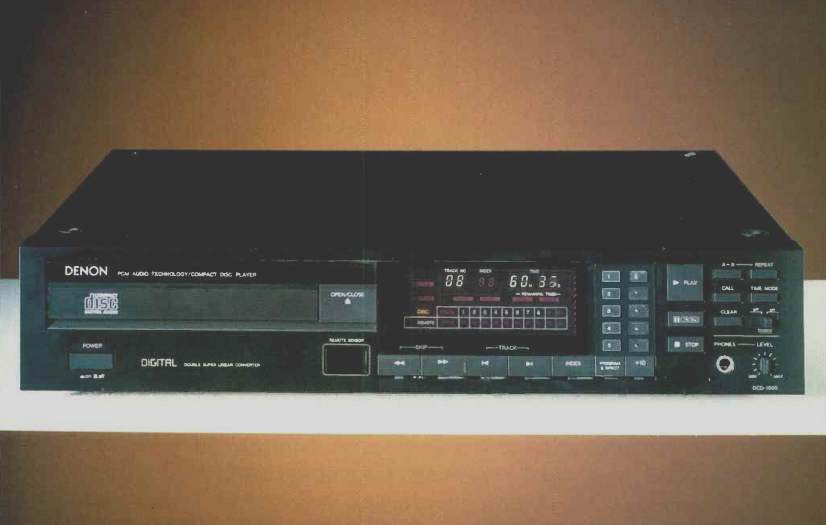
Manufacturer's Specifications
Frequency Response: 5 Hz to 20 kHz, ±0.3 dB.
Dynamic Range: 96 dB.
S/N Ratio: 96 dB, A-weighted.
THD: 0.0025% at 1 kHz.
Channel Separation: 95 dB.
Number of Programmable Selections: 20.
Output Level: Fixed, 2.0 V rms; variable, 0 to 2.0 V rms.
Dimensions: 17 1/2 in. W x 3 1/2 in. H x 14 in. D (44.5 cm x 8.9 cm x 35.6 cm).
CHIPSET: 2xPCM54HP-K (dac) and 2xSM5801P (2x oversampling digital filter, DP) ; one per channel. Not much info about this DF avail (i.e., datasheet). Note that PCM54 is parallel-input DAC chip (Not I2S). These DACs require a de-glitcher ckt following dac (before LPF ckt and output).
Service Manual for DCD-1500: Avail. online, free PDF. Use Google to seach.
Weight: 13.2 lbs. (6 kg).
Price: $629.95; wood side panels, $30 per pair.
Company Address: 27 Law Dr., Fairfield, N.J. 07006. USA.
With so many low-cost CD players now available, I think a lot of us tend to forget that there are several companies which still offer a wide variety of CD players in many price categories. The higher priced units often deliver more than just increased programmability, remote control, and other convenience features; some actually provide better sound when compared with their lower priced counterparts. Denon's DCD-1500 is such a CD player. It does indeed offer a wireless remote control (which operates virtually all of the front-panel functions, plus volume) as well as full random programming of up to 20 selections. Certainly it provides several repeat-play modes and a display area that tells you just about everything you need to know about the player's operation. Still, my own enthusiasm for the DCD-1500 stems more from its circuitry and sonic performance than from its admittedly advanced and easy-to-use operating features. More about the sound quality of this excellent machine shortly; first, let's take a look at its superb ergonomics.
Control Layout
A slide-out drawer with its "Open/Close" pushbutton is at the upper left of the front panel; below the drawer is a "Power" on/off button. A large, well-illuminated, and easy-to-read display area to the right of the disc drawer indicates track and index numbers, time elapsed (or remaining time), presence or absence of a disc, and programmed track numbers (from 1 through 20). Below the display are separate pairs of pushbuttons for track skipping (forward and reverse) and for audible search in either direction.
A pushbutton labeled "Index" and another called "Program & Direct" are used, together with 10 numbered keys, to call up specific tracks or indexed passages for immediate play, or to enter up to 20 tracks for programmed play. A pushbutton labeled "+ 10" facilitates accessing track numbers above 10; if you wanted to play track 28, for instance, you would touch the "+ 10" button twice, then the "8" button, and then either the "Play" button or (if you were storing the command in the program memory) the programming button. A large "Play" button, along with "Pause" and "Stop," are to the right of the number keys. Still further to the right are buttons which activate the various repeat-play modes (track, entire program, or entire disc), clear a pro gram from memory, recall previously programmed information, and switch from an elapsed-time to a remaining-time display. A timer-start switch, also at the right o' the panel, allows the DCD-1500 to be turned on or off by an external timer.
At the lower right corner of the panel are a stereo phone jack and a level control for the phone output signal. The rear panel is equipped with the usual left and right output jacks as well as a subcode output jack for use with video-graphics adaptors when they become available to consumers, sometime in the near future.
Measurements
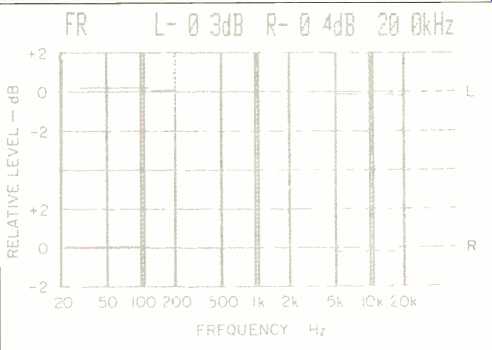
Fig. 1--Frequency response, left (top) and right channels.
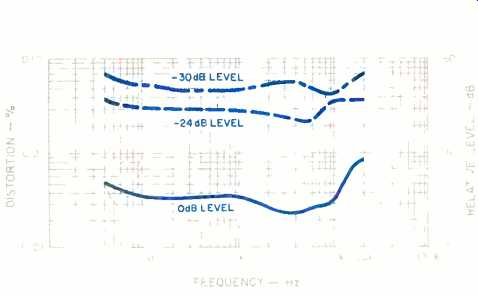
Fig. 2--Distortion vs. frequency at three recorded levels.

Fig. 3--Spectrum analysis of 20-kHz test signal shows no out-of-band components
other than a minute "beat" at 16 kHz.

Fig. 4--S/N analysis, unweighted (A) and A-weighted (B).
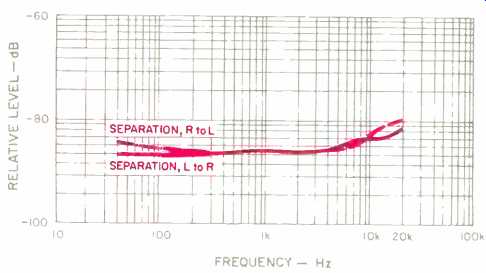
Fig. 5--Separation vs. frequency.
Frequency response for the Denon DCD-1500 (Fig. 1) was extremely flat, deviating from perfect flatness by no more than +0.2 and -0.4 dB from 20 Hz to 20 kHz. Total harmonic distortion at 1 kHz for a 0-dB (maximum recorded level) test signal was 0.004%. What's remarkable about the distortion characteristics of this player is that even at the high-frequency extreme, where I normally have to introduce a low-pass filter to obtain meaningful THD measurements, the readings on my distortion analyzer remained unusually low (see Fig. 2). The significance of this can best be appreciated if you refer to Fig. 3. In this 'scope photo of a spectrum-analyzer sweep (which is linear, from 0 Hz to 50 kHz), you can see a reproduced 20-kHz signal, but that's all you see, aside from a very minute "beat" at around 16 kHz.
There were absolutely no out-of-band components visible outside the audio spectrum. It's been a long time since I obtained such a clean sweep (pardon the pun) when making this test on CD players; the last two players I tested that exhibited this kind of clean, spurious-noise-free out-of-band output were the Pioneer PD-9010X and the Sony CDP 620ES. Most other players usually produce an out-of-band beat at around 24 kHz when reproducing the high-level 20-kHz signal. I'm not saying that the absence of such out of-band beats results in improved sound quality, but I'm beginning to wonder whether there isn't some sort of subtle correlation. The fact is that the Denon DCD-1500 did sound remarkably smooth and clean during my listening tests, but I'll get to that presently.
Figure 4A shows an analysis of unweighted signal-to noise ratio; it measured 95.7 dB, almost as good as the weighted S/N claimed by Denon. When an A-weighting network was added to the measurement, as shown in Fig. 4B, S/N improved to an even 100 dB, several dB better than claimed by the manufacturer.
Stereo separation was outstanding too. Notice, in Fig. 5, how it remains almost as good at the high-frequency extreme as it is at mid- and low frequencies. Most CD players I've tested recently tend to offer much-reduced separation at high frequencies. In the case of the DCD-1500, separation remained above 80 dB even at 20 kHz. Maintaining this kind of separation involves careful layout of the player's analog output stages as well as complete independence of the digital-to-analog conversion system for left and right audio channels.
Output linearity was excellent, remaining accurate to with in 0.5 dB all the way from maximum recorded level down to 80 dB below that level. SMPTE-IM distortion measured a mere 0.002% at maximum recorded level, increasing to 0.01% at -20 dB recorded level. CCIF-IM distortion was an insignificant 0.003% at maximum recorded level and an even lower 0.0017% at -10 dB. That's as low as I've ever measured, and provides further proof of the nearly complete absence of any intermodulation distortion products generated by the combination of sampling frequency and program content.
As I might have guessed, wow and flutter was too low to be measured by my test instruments, and any pitch error that might be present was also too low to be measured by my frequency counter. De-emphasis networks, automatically switched in when pre-emphasized CDs are played, were accurate to within 0.3 dB. The only parameter that fell short of published specs was dynamic range, which, when measured in accordance with the recently approved EIAJ Standards, was 91 dB as against 96 dB claimed by Denon. It's entirely possible that Denon is measuring this specification in some other way. In any case, a dynamic-range capability of 91 dB is certainly nothing to be ashamed of, by anyone's standards.
Output level for the DCD-1500 measured 2.06 V on one channel and 2.08 V on the other, for a difference of 0.02 V.
Denon employs 88.2-kHz oversampling and digital filtering prior to D/A conversion. This technique results in the extraordinarily clean and accurate 1-kHz square-wave reproduction shown in Fig. 6. What appears to be a minor amount of "ringing" along the top and bottom of the reproduced square wave is not ringing at all, but simply the absence of higher order harmonic components (above 20 kHz) that would be needed in order to yield a perfectly straight horizontal line here.
Figure 7 shows a reproduced unit pulse; its symmetry is consistent with what I have come to expect from CD players employing the type of filtration and oversampling used by the DCD-1500. As for the sine waves shown in Fig. 8, they are perfectly in phase with each other, indicating that Denon is using two separate D/A converters (one for each channel).
This technique avoids the usual 11.3-uS delay which occurs between channels when a single D/A converter is "multiplexed" to recover separate left and right signals.
I would have been very surprised if this superb player had not been able to play through my defects disc without any skipping or muting. In fact, it did play through the maximum width of the opaque wedge, the maximum-diameter dust simulation, and the simulated fingerprint smudge without so much as a hint that there was anything wrong with the test disc. It also successfully tracked a damaged disc that I keep around in the laboratory for just such rigorous testing--a disc that has been rejected by more than one CD player in the past.
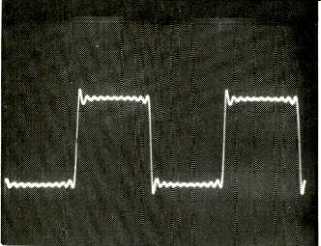
Fig. 6--Reproduction of a 1-kHz square wave.

Fig. 7--Unit-pulse test.
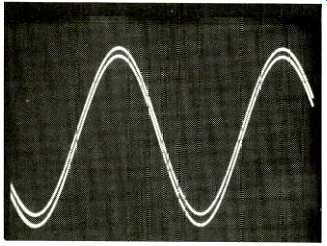
Fig. 8--Interchannel phase match when playing 20-kHz test tone shows that
separate D/A converters are used in each channel.
Use and Listening Tests
I suspect that I am sometimes influenced by what I mea sure on the test bench when it comes time to judge a product's sound-reproduction qualities. I'm convinced that we can "psych" ourselves into hearing subtle qualities that we want to hear, or that we expect to hear. To me, the sound of the DCD-1500 seemed a shade better than what I have been hearing of late from several CD players whose measurements haven't been quite as good as this one's. I wanted to be sure that the measurements weren't prejudicing me, so I called in two friends who own CD players and asked them to bring their players along to my listening room. Without knowing when they were listening to their own players and when they were listening to the Denon, both of these friends preferred the sound of the DCD-1500 over that of their own.
I've always wanted to believe that, ultimately, there is a correlation between measured results and audible results providing the right measurements are made. Happily, that contention held true in the case of the DCD-1500. It not only performed well on the bench and was easy to use via its remote control or via its front-panel controls, but it sounded as good as any CD player I have tested so far. What's more, its price is a good deal lower than that of some of my other favorite CD players. It is a winner in my book on every count.
-Leonard Feldman
(Adapted from Audio magazine, Jun. 1986)
Also see:
Denon DCD-3520 Compact Disc Player (Equip. Profile, June 1989)
Mod Squad Prism Compact Disc Player (Auricle, Aug. 1988)
Mission PCM-7000 Compact Disc Player (Aug. 1987)
= = = =